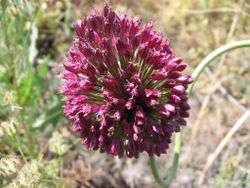Allium sphaerocephalon
Allium sphaerocephalon is a plant species in the Amaryllis family known as round-headed leek and also round-headed garlic, ball-head onion, and other variations on these names. Other names include Drumsticks, and in Germany, Kugellauch. Some publications use the alternate spelling A. sphaerocephalum.[2] It is a hardy perennial plant.
| Allium sphaerocephalon | |
|---|---|
 | |
| Scientific classification | |
| Kingdom: | Plantae |
| Clade: | Tracheophytes |
| Clade: | Angiosperms |
| Clade: | Monocots |
| Order: | Asparagales |
| Family: | Amaryllidaceae |
| Subfamily: | Allioideae |
| Genus: | Allium |
| Species: | A. sphaerocephalon |
| Binomial name | |
| Allium sphaerocephalon | |
| Synonyms[1] | |
|
Species synonymy
| |
Allium sphaerocephalon is found in the wild across all parts of Europe except in the northernmost countries (Ireland, Netherlands, Scandinavia, and the Baltic States).[3][4] Its native range extends to northern Africa and to western Asia as far east as Iran.[5] It is also reportedly naturalised in New York State in the US.[6] In the UK it grows wild only in the Avon Gorge so is known locally as the Bristol onion.[7]
The species is prized by gardeners because of its striking floral display. The spherical "head" (technically an umbel) is borne on a long scape, up to 50 cm in height, usually in July. It can contain hundreds of deep purple flowers.[5]
This plant has gained the Royal Horticultural Society’s Award of Garden Merit.[8]
Description
Allium sphaerocephalon produces egg-shaped bulbs. Small bulblets are present under the outer layer of the stem (making the plant potentially invasive when grown in gardens). Flowers are borne on a scape up to 50 cm in height, in a spherical to egg-shaped umbel, 1–6 cm in diameter, tightly packed with many flowers crowded together. The relatively small size of the umbel relative to the height of the stem makes this one of those described as 'drumstick alliums'. Individual flowers are reddish-purple and are occasionally replaced by bulbils (again making this a potentially invasive species).[3]
- Subspecies + varieties[1]
- Allium sphaerocephalon var. aegaeum (Heldr. & Halácsy) Hayek - Aegean Islands
- Allium sphaerocephalon subsp. arvense (Guss.) Arcang. - Sicily, Malta, Albania, Greece, Turkey, Cyprus, Syria, Lebanon, Egypt, Algeria, Tunisia, Morocco[9]
- Allium sphaerocephalon subsp. laxiflorum (Guss.) Giardina & Raimondo - Sicily[9]
- Allium sphaerocephalon subsp. sphaerocephalon - much of Europe plus Morocco, Canary Islands, Middle East
- Allium sphaerocephalon subsp. trachypus (Boiss. & Spruner) K.Richt. - Greece and Turkey incl Aegean Islands[9]
- formerly included[1]
- Allium sphaerocephalon subsp. durandoi, now called Allium ebusitanum
- Allium sphaerocephalon subsp. ebusitanum, now called Allium ebusitanum
- Allium sphaerocephalon subsp. rollii, now called Allium amethystinum
- Allium sphaerocephalon subsp. sardoum, now called Allium guttatum subsp. sardoum
- Allium sphaerocephalon var. scaberrimum, now called Allium scaberrimum
References
- Kew World Checklist of Selected Plant Families
- E.g. Mathew, Brian (1978), The Larger Bulbs, London: B.T. Batsford (in association with the Royal Horticultural Society), ISBN 978-0-7134-1246-8
- Davies, Dilys (1992), Alliums : the ornamental onions, London: B.T. Batsford (in association with the Hardy Plant Society), ISBN 978-0-7134-7030-7, p. 135
- Altervista Flora Italiana, Schede di botanica, Allium sphaerocephalon
- Missouri Botanical Garden, Gardening Help, Allium sphaerocephalon
- Biota of North America Program, Allium sphaerocephalon
- "Bristol Onion". Bristol University. Retrieved 2014-10-08.
- "RHS Plantfinder - Allium sphaerocephalon". Royal Horticultural Society. 2016. Retrieved 5 January 2018.
- Kew Royal Botanical Garden, London, Allium sphaerocephalon
External links
- Comprehensive profile for Allium sphaerocephalon from the website MaltaWildPlants.com
| Wikimedia Commons has media related to Allium sphaerocephalon. |
.jpg)